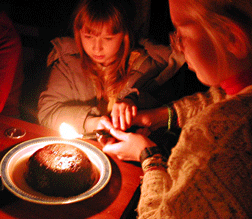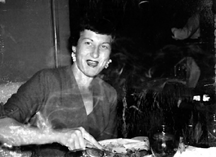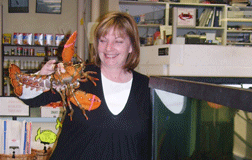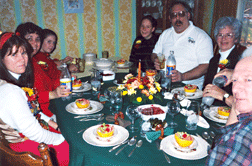
|
Volume 16, Issue 45 - November 6 - November 12, 2008
|
|
Columns |
The Thanksgiving Feast
Beyond the basics, we make America’s holiday our own
 |
The lighting of the plum pudding, is a tradition in Dotty Holcomb Doherty’s family. |
Thanksgiving dinner is served out of the great American melting pot. While tracing hand turkeys on construction paper, we imbibed the traditions of the great Pilgrim feast. So committed are we to turkey, dressing, cranberry sauce and pumpkin pie that we must have sworn long-forgotten cross-my-heart oaths to make them the staples of Thanksgiving forever and ever.
Don’t get me wrong. I like turkey, dressing, cranberry sauce and pumpkin pie. I cook and serve them with love every Thanksgiving.
But sometime between then and now, my heart swelled with thanks for my own identity. So there are icons at my Thanksgiving table beyond idealized pilgrims and ceramic turkey salt and pepper shakers. Nowadays, I prepare my feast to honor my culture, family and mother as well as the great American ethos we all share, whether our roots are in Italy, Ireland, Africa or Indonesia.
Is it not the same for you?
While eating 2007’s Thanksgiving leftovers, the Bay Weekly family of writers began collecting the recipes and stories that add the spice of personal — and local — tradition to each Thanksgiving feast. Yes, downstream from Baltimore, many include sauerkraut.
As the 2008 feast revives your memories, add your recipes, stories and photos to our collection ([email protected]) for posting in our online edition.
Our Pilgrim Path
 |
Although food was the family business when Sandra Olivetti Martin grew up, her mother, Elsa, was stymied by pies. |
Food was our family’s business and its religion. Immigrant Italian grandmother Catherine Bergamino Olivetti supported her family by feeding Southern Illinois coal miners. But poverty pinched, and my mother Elsa’s stories always featured food and scavenging: She spent hoarded pennies on candy rather than soup meat, gorged on onions drying in the barn rafters, stole potatoes from freight trains to bake in campfires. Often the consequences were dreadful.
When my father and mother opened their restaurant, mother cooked. She cooked by taste, never using a cookbook, and developed a multinational repertoire drawn from the culinary memories of immigrants from many nations. I’ve traced her spareribs and sauerkraut to its Alsatian roots as choucroute garni, and I still cook it. But no one in our family has ever served it for Thanksgiving.
Mother could cook anything — within the boundaries of her era — except desserts. That deficiency became evident every Thanksgiving, when she baked her annual thick-crusted pies, pumpkin and mincemeat. I’ve perfected the fillings of both, carving up pumpkins for the first and stew meat for the second (which I prefer at Christmas). But it took a third generation to get the crust right. Both my sons, Elsa’s grandsons, bake prize-winning pies.
A second-generation immigrant conceived in the old world, my mother set out on her own migration to the big city at 14. She was our pilgrim, and she gave us the right to find our own way — as long as we seasoned our recipes with love, cooked plenty and insisted that everybody overindulge.
–Sandra Olivetti Martin
Straying off the Path
Thanksgiving was my mother’s holiday, and the meal she prepared was dependably traditional. There was never any variation in menu or recipes: The turkey was roasted the same way every year. The bread stuffing straight out of Betty Crocker’s red-and-white-checkered cookbook. Mashed potatoes with nothing but milk, butter, salt and pepper — garlic would be sacrilege. Candied yams cooked in Mom’s electric skillet. Canned jellied cranberries. Relish tray with green and black olives. Pumpkin pie.
It was tasty, but always exactly the same.
 |
Bucking tradition this year, Margaret Tearman will be cooking fresh Maine lobster for herself and husband Tom. |
After leaving home and moving across the country, I, as a single woman, usually bummed dinner off friends and their families. Welcomed into their fold, I gratefully dined on their family favorites — which usually turned out to be a variation of my mom’s.
In married life, my family of two — husband Tom and I — eventually expanded to include friends without partners or near-by relatives. We started our own tradition and hosted Thanksgiving dinner for our adopted clan. The dinner from my kitchen always centered on turkey, bread stuffing, mashed potatoes, yams and, well, pretty much the same menu I grew up with. Out-of-the-norm additions came from a rogue guest, one of the more memorable being a contribution from a Baltimore son and his girlfriend: Sauerkraut and kielbasa. Delicious.
Last year I tried to bag the whole mess and dine out. Faced with appalled resistance, I relented and prepared the same old feast.
This year our tradition has gone north. With two new babies and aging parents, our adopted family is heeding the call of blood and will be spending the holiday with their real family, leaving Tom and me to celebrate Turkey Day solo.
My spouse agrees the whole turkey thing is too much work for just two. Betty Crocker’s gingham guide — inherited from my mom with its stains and ripped pages — will stay on the shelf.
This year our holiday meal will start off with an appetizer of local oysters, shucked and served au natural. Instead of roasted turkey, I will grill Maine lobster and bay scallops over an apple wood fire.
As for accompaniments and a dessert? I’m not sure of what pairs well with oysters, lobster and scallops and so I’m open for suggestions: [email protected]
–Margaret Tearman
Yankee Tradition Meets Bob Cratchit’s Turkey and Lime Jell-O
In New Hampshire we have three traditions Marylanders might consider odd. First and foremost, it’s called stuffing, not dressing — which is for salad. Second, we prefer whole-berry cranberry sauce, not jellied. As tenders of the crop, Yankees claim the right to set the standard, and there’s something quite Puritanical about having to work harder and chew for those sweet calories. Third, we have squash pie for dessert, not pumpkin.
But sauerkraut for Thanksgiving? What a ridiculous notion!
 |
Breaking with Thanksgiving tradition is risky, as Jane Elkin’s daughter discovered when she served Jell-O salad with the main course. |
I never saw pumpkin pie until I moved to the mid-Atlantic as a young adult. Now I prefer its density and sweetness, but it feels odd to break with tradition on Thanksgiving. Since I can’t find a can of squash pie filling in Annapolis, my father brings it in his suitcase. I considered making my own from acorn, butternut or Hubbard squash, but it wouldn’t be the same. And isn’t that what tradition is all about? Cooks who tamper with family favorites are rewarded with sad eyes, suspicious glances and sneers.
Introducing new traditions is acceptable but tricky, as my daughter discovered when she served Jell-O salad with the main course, in the style of her Midwestern relatives. New Englanders consider Jell-O dessert, so most of our guests passed it by. My father took some and went rummaging in the refrigerator for whipped cream. He wanted to please his granddaughter, but he misunderstood her intent.
As for the bird, we are not brand loyal. Living in Switzerland in 1989, our only option was to special order. When my husband picked up our fresh, free-range French turkey on his way home from work, he was handed a big cardboard box. Inside was a naked bird, covered only by one sheet of wax paper. He walked a mile home with it on his shoulder, like Bob Cratchit, balancing its weight against his briefcase, with a pack of dogs at his heels.
I wanted to cry when I saw it, all pale and scrawny, with feathers still clinging to the skin and big gashes with ground-in dirt, as if the butcher had chased it all the way from France with a cleaver. We washed it and crammed it into our tiny oven with a wish and a prayer. It was the best turkey ever.
Thanksgiving is the one meal you don’t mess with. The cook may innovate to enhance and substitute if absolutely necessary, but the creamed onions stay on the menu — until a new majority rules.
Lime Jell-O Salad
• 1 small package lime Jell-O
• 1 small package cream cheese, softened
• 1 small can pears, drained
• 1 cup chopped pecans or walnuts
Using a fork, mash Jell-O powder into cream cheese in an oblong glass baking dish. Add water as directed on package, and stir well, adding nuts. Arrange pears on bottom of dish with cut sides down, and pour Jell-O over fruit. When firm, cut in squares and serve on a bed of lettuce.
–Jane Elkin
All in Our Family
Sauerkraut: No good half-German family can eat a meal without it.
I do believe it’s a Baltimore thing. Every Baltimorean that I know feels that sauerkraut is a Thanksgiving dish.
There was a huge German community in Baltimore, though many moved to the suburbs in the 1970s. Even my father’s English-Irish family was surrounded by sauerkraut in their section of West Baltimore. My grandfather couldn’t stand the smell and had to shut all the windows and keep doors closed during major holidays.
After World War I, the names of many streets in Baltimore were changed to sound more American. But food traditions were one of the few cultural aspects that remained unchanged.
Jelly Cranberry Sauce: Slice and layer it thinly over turkey, both on the day of Thanksgiving and for all the post-feast sandwiches. You cannot do this with whole-berry sauce.
Turkey: My mother brines it for hours, curses at it then does not want to eat it. The rest of my family doesn’t really like turkey, yet the tradition continues.
Mashed potatoes: They must be hand-mashed using my grandfather’s ancient, grid-ended potato masher. Whipped potatoes will not do — and everyone in my family can tell when the potatoes have not been properly mashed with the appropriate tool. The tool is given to the youngest able-bodied family member, i.e., me.
Krispy Kreme Bread Pudding: I made the recipe on a lark last year after seeing it on the Food Network program Paula’s Party. It vanished from the serving dish after making only one round of the table.
Krispy Kreme Bread Pudding
• 2 dozen Krispy Kreme donuts
• 1 (14-oz.) can sweetened condensed milk (not evaporated)
• 2 (4.5-oz.) cans fruit cocktail (undrained)
• 2 eggs, beaten
• 1 (9-oz.) box raisins
• 1 pinch salt
• 1 or 2 tsp. ground cinnamon
Preheat oven to 350 degrees F.
Cube donuts into a large bowl. Pour other ingredients on top of donuts and let soak a few minutes. Mix all ingredients together until donuts have soaked up the liquid as much as possible.
Bake for about an hour until center has jelled. Top with Butter Rum Sauce.
Butter Rum Sauce
• 1 pound box confectioners’ sugar
• 1 stick butter
• Rum, to taste
Melt butter and slowly stir in confectioners’ sugar. Add rum and heat until bubbly.
–Diana Beechener
Why Not Innovate?
Last year, to celebrate my husband’s 80th birthday, we took a trip to Spain, a country he had always wanted to visit. We ate magnificent paellas there, and when we arrived home just a few days before Thanksgiving, I decided to cook one myself for the 12 people who would be dining with us on Thanksgiving Day.
Alas! When I floated the idea past my sister-in-law and my son and his family, I heard nothing but groans of horror. What, no turkey? I was irritated at how inflexible they were.
So, jet-lagged up to the eyeballs, crammed with overwhelming images of Spanish delicacies, I decided to compromise. I cooked my paella on the evening before Thanksgiving for my overnighting family members, then I spent all the next day cooking the darn turkey and its handmaidens.
I still believe that paella would make a marvelous, showy Thanksgiving meal, and I vow to stick to my druthers some year when the rest of my family decides to stay home and I can invite guests who will be polite enough to eat whatever I provide.
But sauerkraut with paella? Good heavens, no!
Ginny Hall’s Spanish Paella
Serves 8
• 1⁄4 cup olive oil
• 8 chicken thighs (skinned)
• 6 chorizo sausages, sliced
• 1 cup diced onion
• 2 cloves garlic chopped or pressed
• 2 diced red peppers
• 1 tsp. saffron threads*
• 1 tsp. dried red chili pepper flakes (less if you like it milder)
• Large bay leaf
• 1 tsp. thyme
• 2 cups rice
• 4 cups hot chicken stock
• Salt to taste
• 1 pound raw or cooked shrimp
• Cleaned clams or mussels
 |
Sage is Val Lester’s granddaughter and a good Thanksgiving herb. |
Dissolve the saffron in the hot stock. Set aside. In a large frying pan or wok, heat the olive oil. Add onion, chicken and chorizo and sauté 10 to 15 minutes (depending on size of chicken thighs). Then add red peppers and garlic. Cook one minute. Stir in pepper flakes, bay leaf and thyme. Add rice, and slowly pour in the hot, saffrony stock. Add salt to taste. Stir all together. Bring to the boil, and then lower heat to simmer slowly. Cover and cook for 15 to 20 minutes, until rice has absorbed the stock. Add shrimp, cover, and cook an additional four minutes if raw, two minutes if already cooked.
I am desperately allergic to clams and mussels. If you want their panache, cook them first, set them aside and use the water in place of chicken stock. Add for the last minute to warm through.
*Saffron can be expensive, but Trader Joe’s has the best deal in town. There’s a rash of people naming their daughters Saffron. I don’t have a Saffron in the family, but I do have a granddaughter called Sage, a good Thanksgiving herb.
–Valerie Lester
Post-Modern Thanksgiving
When our daughter became a vegetarian, eating neither fowl nor fish, she added a new recipe to the Thanksgiving feast. It went well with the sauerkraut:
Tofu Chili
4 servings
• 1 Tbs. oil
• 2 small onions chopped
• 2 garlic cloves chopped
• 1⁄2 pound tofu
• 11⁄2 tsp. chili powder or more to taste
• 1 tsp.cumin
• 28 oz. can crushed tomatoes
• 15 oz. can red kidney beans rinsed and drained
• Brown or white rice cooked
Sauté onions and garlic in oil until almost tender. Add tofu and spices. Add crushed tomatoes, beans and cook for 20 minutes. Serve over cooked rice.
–Bill Wohlfeld
Irish Sweets and Louisville Leftovers
After feasting on Thanksgiving dinner in our family’s New Hampshire farmhouse, we gather to light (and eat) the bourbon-soaked plum pudding, anticipating the magical blue flame that licks across the top of the cake and swirls around the plate. The recipe, handwritten by my husband’s Irish grandmother, was kept in a safe deposit box for decades. My mother-in-law makes it every year for that day, and several others for family to take home for Christmas.
The day after Thanksgiving, our leftover turkey transforms into Hot Browns. This cherished family meal stems from my husband’s Kentucky roots. The Hot Brown sandwich, developed in 1920, was a signature dish of Louisville’s Brown Hotel.
Lay sliced turkey on toasted bread. Pour on Mornay sauce (white sauce richly laced with sharp cheddar cheese and touches of mustard and Worcestershire sauce), layer with two strips of cooked bacon and sprinkle with Parmesan cheese. Heat under broiler until sauce browns.
We serve them with leftover stuffing, whole cranberry sauce and cranberry-orange relish.
Plum Pudding
Yields three; prepare at least two to three weeks before serving
• 2 cups each: ground suet, bread crumbs (dry white bread, grated), sugar, flour
• 1 pound each: seedless raisins, golden raisins, currants
• 1 cup chopped citron
• 1 Tbs. each: chopped lemon peel, chopped orange peel (more as desired)
• 2 tsp. baking powder
• 1 tsp. each: ground cinnamon, ground ginger
• 1⁄4 tsp. each: ground cloves, ground nutmeg, mace
• 1 Tbs. salt
• 1 cup each: grape juice, bourbon
Combine all dry ingredients. Add fruit, then mix in liquids. Add more liquid if necessary, though mixture should be fairly stiff.
Grease three steamed pudding molds; fill two-quarters full and cover.
Place molds on trivet in heavy kettle over one inch simmering water. Cover kettle. Check level of water frequently. Steam 5 to 6 hours.
Remove covers from molds and turn upside down onto rack. Puddings will drop out when cool.
Douse with bourbon and place in plastic bags. Store a year or more, occasionally remoistening with bourbon, especially when getting ready to use. Steam to heat before serving.
To serve, place warmed pudding on plate, pour a few ounces of bourbon or rum over top, and light. When flames subside, eat with hard sauce made from confectioner’s sugar, butter, vanilla and rum.
–Dotty Holcomb Doherty
Our Thanksgivings Have Seldom Been Traditional
Our Thanksgiving this year was so untraditional because everyone was scattered in newer configurations, but [husband] Clyde Farnsworth, my daughter Cameron and I went out for a non-turkey supper. Saturday evening, however, we feasted on the bargain turkey she had not resisted picking up and salad and wine.
Skatefish may not be so traditional, but it is what we ate for Thanksgiving in Malaysia in 1976. And during all my vegetarian years I preferred fish to turkey.
Green tomatoes are appropriate for Thanksgiving, to use up those that never had time to ripen before the cold.
Thanksgiving with Great Aunt Eugenya is a tale of an effort toward a more traditional Thanksgiving, which ours have seldom been entirely.
–Elisavietta Ritchie
Thanksgiving with Great Aunt Eugenya
Her mostly blind eyes could still see
bright colors, and my salad gleamed:
red peppers, yellow squashes, green beans.
She lifted the silver serving spoon
over the gold-rimmed plate,
inspected it closely, recalled
a bullet she had extracted
from the gangrenous leg
of a soldier in a hospital tent.
The doctor killed, she learned
to amputate on the battlefield.
Not quite dinner conversation but
she was a nurse, World War One.
Well-born young ladies signed up,
no eligible men left in Petersburg.
No man in my house, and because
I was unsure where to begin,
Great Aunt Eugenya carved the turkey.
Her fingers were skilled in the Braille
of bones, and understood flesh.
The glistening skin stayed intact.
Hungry for history and science,
my daughter and I asked questions.
My aunt described fighting, famine …
After the Revolution
the Bolsheviks put her to work
in a prison camp. As a nurse
she could sign out the sick
to hospital: there they’d get better
rations, a chance to escape.
Finally she too fled, to Estonia,
Germany. Another war …
Then the Red Army advanced …
She reached England, America.
Through years as a nurse
she kept her tin army cup.
Born in a safer land and time,
I carry the burden of not
suffering war first-hand.
Best I can do is hear out, absorb
others’ lives, try to nurture them.
My daughter became a doctor,
also learned war firsthand —
C-rations on Thanksgiving.
Cyprus, Korea, Somalia.
Meanwhile, we don’t recite grace but
in silence thank God for turkey,
colorful vegetables, this interim peace.
Published in The Ledge, 2000 and in Awaiting Permission to Land, Cherry Grove Series, 2006.